On-demand apps are a convenient and time-saving option for modern-era customers. Here’s one such amazing On-demand ordering app, Exut! It allows users to instantly place an online order while on-track driving and quickly grab essentials on the go. Exut has consolidated multiple stores that have uploaded their products which include essentials, beverages, alcohol, etc. Exut comes with the user module and the merchant module. Here’s how the app works.
The Complete Guide to Charts and How They Help Marketers and Businesses to Get Growth
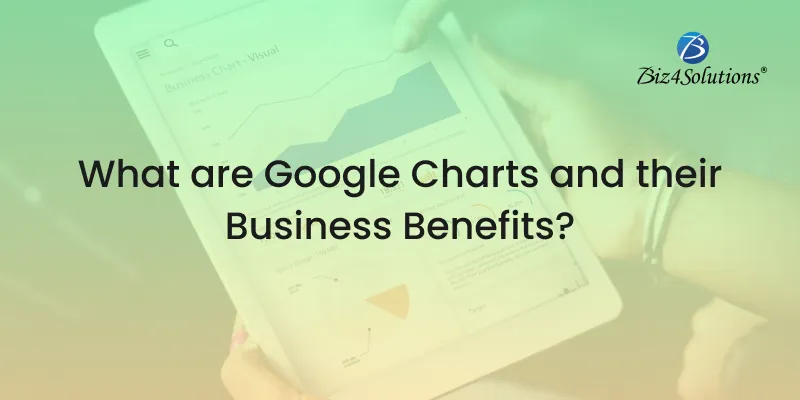
Charts are a visual representation of data. You can use charts to display information quickly and easily. Charts integrate text with graphics or symbols to indicate the relationship between several data sets. Take a look at these examples. You can use a bar chart for indicating the sales pattern of a product over a certain timeline say a few years. The length of a bar in the chart signifies the product sales for a specific year.
Charts are a great way to convey complex information and compare several data sets. This is because pictorial representation is often a more powerful tool to display information. Research has proven the fact that it’s easier to understand and remember data represented visually via charts over plain textual data. This way, viewers can grasp the insights faster and more effortlessly. Google Charts is also an effective tool for data analysis and identifying trends, patterns, and outliers. This is the most popular form of charts leveraged by modern-day entrepreneurs. Businesses are using these charts as a productive way of data visualization on their websites or web/mobile apps. The Google chart gallery comes with a huge variety of ready-made charts starting from simple line-based charts to complicated ones like hierarchical tree maps.
What do you need to know about Google charts?
Google-based charts are web-based solutions that help software development teams visualize their website data in the form of histograms, pictographs, etc. These charts are Cloud-based and allow software development teams to create various types of interactive graphs and charts for displaying crucial data on their websites.
Google’s visualization API powers the charts, So, web app development teams can effortlessly integrate these charts into web apps. Anyone having a Google account can access it.
The charts are exposed as JavaScript classes and rendered with the help of SVG/HTML5 technology. This provides cross-platform portability to Android & iOS devices and cross-browser compatibility including VML for old IE versions. Entrepreneurs can even feed data into charts and create chart-related objects with the help of a selected ID.Users can refer to the google charts documentation to seek assistance and resolve other queries.
Why is it important to use Google charts?
- It is free to use and comes with a user-friendly interface.
- It is an easy way to make a data visualization for your blog post or website.
- You can use it to display data in a variety of formats, from bar graphs to pie charts.
- Data visualization is the process of converting information into a graphical format that can be quickly comprehended and shared with others.
Features of Google-based charts?
- Content Management
- Custom Dashboards
- Compatibility with different browsers and mobile platforms.
- Multitouch Support
- Lightweight
- Simple Configurations
- Visual Discovery
- Multiple axes
- Configurable tooltips
- Date Time support.
- Dataset Management
- Print using a web page
- External data from a server
What are some benefits of using Google-created charts?
- Easily create charts with built-in templates.
- A large library of chart types to choose from.
- Flexible chart options to change colors, fonts, etc.
- Simple tools to animate data in a chart or make changes to it over time.
However, in order to reap the benefits of this javascript-based data visualization library to the fullest and achieve your goal, it’s important to select the right kind of chart. There are a wide variety of Google-provided charts. Each type of chart serves a specific purpose. You need to identify your objective and then select the chart type that best fits your requirement
TYPES OF GOOGLE CHART
How Easy They Are!
Google’s Charts are important because they allow data visualization in the browser with no need to download and install a plug-in.
The Google Chart API is a JavaScript library that lets users create graphs, charts, and maps in the browser without having to download or install a plug-in. With this API, developers can create interactive visualizations for websites and applications.
Some of the Visual EXAMPLES of the charts generated through google’s charts:
In the below Charts, we have merged the dataset to showcase the different formats. The Colored Labels Consists of Their Types:
How to integrate Google chart Pie
<!DOCTYPE html>
<html>
<script type="text/javascript" src="https://www.gstatic.com/charts/loader.js"></script>
<body>
<div
id="myChart" style="width:100%; max-width:600px; height:500px;">
</div>
<script>
google.charts.load('current', {'packages':['corechart']});
google.charts.setOnLoadCallback(drawChart);
function drawChart() {
var data = google.visualization.arrayToDataTable([
['Contry', 'Mhl'],
['Italy',54.8],
['France',48.6],
['Spain',44.4],
['USA',23.9],
['Argentina',14.5]
]);
var options = {
title:'World Wide Wine Production'
};
var chart = new google.visualization.PieChart(document.getElementById('myChart'));
chart.draw(data, options);
}
</script>
</body>
</html>
Challenges Faced While Integration
1. Displaying real-time data without reloading the page.
Solution: - By using jQuery.
Click Here for Code
2. User interface customization in accordance with the client's requirements.
Solution: - By using bootstrap and with the help of jQuery.
Click Here for Code
3. Customizing the filters and labels that appear on the charts.
Solution: - With the help of HTML, CSS, and jQuery.
Click Here for Code
4. Retrieve the necessary data from the backend to present the results.
Solution: - Write an API in Laravel (PHP) to get the data and prepare by using jQuery to Display the google chart.
In Conclusion
Data visualization with Google-provided Charts can work wonders in your web development process. And, the good news is that the charts are continuously being updated with new features and enhancements to stay relevant as per the changing trends and offer advanced functionalities to users.
However, you must take care that your chart is captivating enough to make your point more convincing and add credibility to the presentation. Also, follow the best practices while you implement these charts. You may consider hiring professional Google chart developers if your requirements are complex and you lack the necessary expertise.
The transportation and logistics industry must necessarily adopt IoT-powered app solutions to smarten their workflow and eliminate the existing challenges.
These smart apps automate the workflow and hence, ease out the management of the supply chain, inventory, warehouses, and fleet; helps in optimizing routes and rule out chances of errors.
Biz4Solutions excels in developing remarkable IoT based transportation applications that will transform your business operations for a more productive outcome.
We aim at creating transport and logistics app solutions that improve customer services, enhance the efficiency of your supply chain and boost your ROI as well.
Would you like to harness the potential of IoT for maximizing profitability? Partner with us and we will build a customized software solution to revamp your transportation business.
Contact us to discuss your project requirement! Visit our webpage - https://www.biz4solutions.com/iot-in-... and check out our transportation domain success stories.
Flutter Performance Optimization Techniques & Best Practices
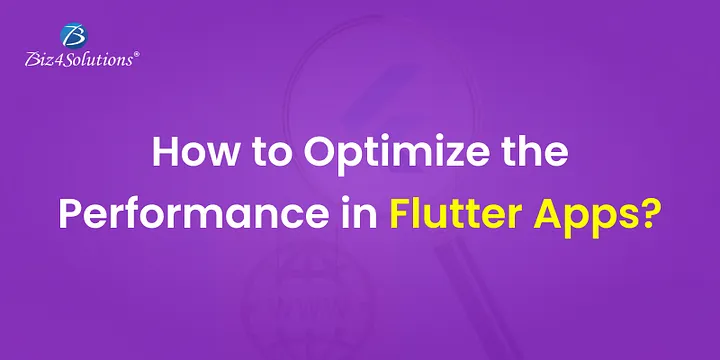
Flutter is a robust cross-platform framework used to build visually attractive and natively-compiled applications using a single codebase. With this framework, you can create solutions for the web, mobile, and desktop. Flutter delivers a native-like look and feel to apps on iOS as well as Android devices. Flutter comes with numerous other benefits like flexibility, app development speed, etc., and is loved by software development teams across the globe.
However, to achieve the best outcomes from this amazing framework, you must take care of a Flutter app’s performance tuning during the development process itself. A poorly optimized Flutter app is likely to be slow & unresponsive, consume more power, and require more time & resources during the development process. This will adversely affect the user experience, app store ratings, as well as the app owner’s budget. But, by implementing the right performance techniques & strategies you can develop a highly performant Flutter app that delivers a smooth UX. This post discusses the best practices to follow for Flutter performance optimization.
Best Practices for Flutter Performance Optimization
Use Widgets instead of Functions
Using Widgets instead of Functions is a key technique to optimize the performance of a Flutter application. While functions define the app’s behavior and manipulate data, Widgets are the UI building blocks app users interact. So, if you use Widgets instead of Functions, your Flutter mobile app will have an interactive and visually attractive UI.
Here are some examples of how you can use Widgets instead of Functions in your Flutter application.
Custom Widget Creation
Developers usually define a function for generating a piece of UI. Well, there’s a better technique instead of this. Build a custom widget that encapsulates the user interface and its behavior. This method will allow you to reuse the widget in various portions of the app and your code will become more modular and maintainable.
Utilization of built-in Widgets
If you do not wish to create a custom Widget, you can choose from a huge variety of in-built widgets that the Flutter framework offers. You can develop complicated interfaces without having to write custom code if you utilize these built-in Widgets. Here are some examples. The TextField Widget helps you to create a text input field. The ListView Widget enables you to display a scrollable item list.
Combining Multiple Widgets
Breaking down Large Widgets into Sub-widgets
It’s a good practice to use stateless widgets wherever possible. During a state change, Flutter redraws stateful widgets. This means developers have to rebuild the entire widget. And, if the size of the build tree is large, you’ll need multiple resources to rebuild it. To address this issue, keep your widgets modular and small-sized for minimizing the size of the build function. So, break down large widgets into smaller-sized sub-widgets.
Using Widgets instead of Functions, your app UI will be more flexible and reusable. But, Functions are necessary to manipulate data and to define the app’s behavior. Therefore, the best practice followed by most experienced Flutter app Developers is using Functions alongside Widgets.
Optimize the Layout & Use “const” keywords
The complexity of a Futter application’s layout is one of the key factors that affect the app’s performance. So, avoid using nested layouts; use them only when necessary. Also, try to keep your widget tree as shallow as possible.
Using “const” keywords is a popular practice for optimizing Flutter app performance. While creating custom Widgets or using the in-built Flutter Widgets, use the “const” keywords wherever you can. This practice will make your widgets immutable. It will minimize the need for rebuilding widgets leading to improved performance. Here’s the reason! If you use “const,” the Flutter development environment will rebuild only the Widgets that need updation. There will be no change in the Widget when setState calls take place and widget rebuilding will not happen. Another recommended practice is saving CPU cycles and using them along with a “const” constructor.
Employ Asynchronous Programming Techniques
During Flutter app development, you must check whether the code is running synchronously or asynchronously. Using asynchronous programming techniques, you can avoid blocking the main thread and this will maintain the responsiveness of your Flutter application. But, it’s challenging to code a Flutter app asynchronously; tasks like upgradation and debugging become difficult to execute. To address this issue, use asynchronous programming techniques like “Futures,” “async/await,” etc. For example, using “async/await,” Flutter developers can write asynchronous code in a synchronous style which increases the code’s readability and maintainability.
Take a look at how to use “async/await” in Flutter:
Step#1
Using the “async” keyword define an asynchronous function before the function definition
Future fetchData() async {
// ...
}
Step#2
Now, use the await keyword inside the asynchronous function to wait for the outcome of an asynchronous operation.
Future fetchData() async {
final response = await http.get('https://example.com/data');
// ...
}
Here, the function http.get() returns a Future. This represents an asynchronous operation that might take some time for completing. The keyword await enables the program to
wait for the result of this operation before continuing.
Step#3
When you call the asynchronous function, use the await keyword to wait for the function to complete.
await fetchData();
The keyword await will enable the program to wait for the completion of the function fetchData()before it moves on to the next line of code.
Build & Render Frames in 16 ms
Creating and rendering frames in your app within 16ms is another common Flutter application performance optimization technique. The tasks of creating and rendering need two separate threads. For each of these tasks, you have 16ms. But, to avoid latency and boost the app’s performance, you need to bring down this 16ms to 8ms. This means, developing the frame within 8ms and rendering it within 8ms so that the total time doesn’t exceed 16ms.
To sum up, create and render the frames within 16ms in a 60 Hz display. Many of you might wonder whether lowering the time can hamper the display quality. The answer is “no.” Bringing down the total time of frame development & rendering to 16ms will not lead to any visibility difference. Rather, it will improve the device’s battery life and prevent thermal issues. Also, this approach will expedite the app performance considerably on smaller-sized devices. The animations of your Flutter app with be smooth and your users will experience a pleasurable UX.
Limit Opacity Use
Cut down the usage of the Opacity widget and Clipping to a bare minimum. When you use Opacity, it causes the widget to rebuild itself after each frame. This can hamper the performance of Flutter applications, and more so if animations are there. To avoid such a scenario, you can apply Opacity to an image directly, instead of using the Opacity widget. This will increase the task’s speed and reduce resource use.
The Opacity Widget allows you to hide another widget on the screen by wrapping it up inside it. So, many use the Opacity widget for hiding a particular widget. The practice of hiding a widget is common in programming languages like Objective-C. But, in Flutter, the approach of hiding a widget on screen for too long turns out to be an expensive affair. There’s a more cost-efficient substitute for this approach. You can rebuild the widget instead of hiding it using a methodology that allows you to reconstruct it without needing the Text widget. And, if you wish to display that widget on the screen you can use the Visibility widget instead of Opacity. It does not involve any fractional opacity values. Visibility has two states- either visible or invisible.
Reduce the App Size
Development teams often end up using multiple packages, codes, widgets, and scripts during the app development process. However, storing such a humongous amount of data can be detrimental to the app’s performance as it consumes high memory.
This issue can be resolved by using the tool called Gradle. This tool helps you to reduce the app’s size. You can also use the Google-introduced packaging system for this purpose. This packaging system allows you to build Android app bundles. With app bundles, you can download the original code from Google Play Store. Here, you’ll find apps that are compatible with the platform architecture and the device.
Minimize Network Requests
The number of network requests can affect your Flutter app’s performance. So, try to reduce network requests as much as you can. You can use caching mechanisms such as StreamBuilder or FutureBuilder for avoiding repeated network requests.
Use Effective Data Structures
Avoid using huge data structures such as maps or lists, when you need to handle large chunks of data in your Flutter application. Instead, consider using efficient data structures such as LinkedHashMap or Set. These data structures fare way better in terms of performance and memory usage.
Optimize Images
Images can turn out to be sources of performance woes, particularly if they are huge-sized and are not properly optimized. Hence, compress images and size them properly. For this, you can utilize tools like “flutter_svg.” This tool helps you to render graphics instead of rasterized images.
Flutter comes with multiple performance optimization tools. These tools enable Flutter app developers to examine and boost the performance of a Flutter application. For instance, the Flutter DevTools allows you to analyze and visualize the performance of your app based on metrics like CPU utilization, memory usage, frame rate, etc.
Flutter performance testing is vital. So, profile your Flutter app at regular intervals for identifying performance issues in the Dart code. Some examples of such issues are i/o, bandwidth, the lack of stuttering, etc. Fix the issues at the earliest. Tools like Flutter Observatory will help you to identify costly operations and optimize them.
Closing Thoughts:
It is important to optimize your Flutter app for performance. An optimized Flutter app ensures device compatibility, provides a great UX, conserves battery life, minimizes app development costs, and improves app store rankings. The aforementioned Flutter performance optimization techniques are the best-known practices trusted by countless developers worldwide. So, partner with a professional and experienced Flutter app development company. A proficient firm will execute your project following the best practices and smart strategies to deliver you a highly performant Flutter end product.
Blockchain-As-A-Service: Overview and Advantages
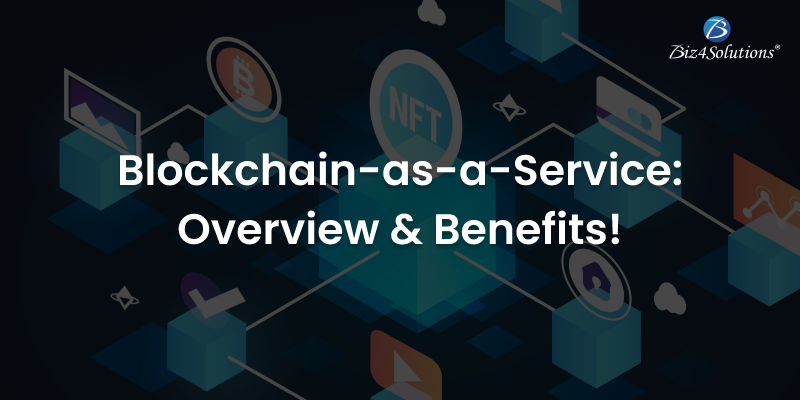
Did you know?
Global expenditure on Blockchain services is estimated to cross 15.9 billion by the year 2023, which was just 1.5 billion in 2018!- as per a report generated by Statista- a renowned online marketplace for statistics.
These staggering numbers portray a massive growth of this technology in just 5 years. Needless to say, Blockchain is going to be a game-changer. Introduced in 2011, Blockchain as a Service has already been the talk of the town and widely adopted by nearly 44% of organizations worldwide.
So, what is Blockchain technology? What is Blockchain-as-a-service? What are the potential advantages it offers to businesses? All such queries will be answered in this write-up.
What Is Blockchain Technology?
The term ‘Blockchain’ represents a digital ledger that enables writing data into ‘blocks.’ Every new block created is added to the previous one, thus creating a chain i.e. Blockchain. Every single block is secured through encryption while writing. In this system, users can access sensitive information using a unique key code. Besides, this peer-to-peer system does not need any third party for managing the transaction, making it a more secure system. Also, this digital ledger cannot be altered after the blocks are added to the chain, hence this system is very authentic.
Though explained in simple terms here, Blockchain is not that easy to implement. The operational overhead and technical complexities involved in developing, configuring, functioning, and maintaining Blockchains stand as a barrier. For instance, it’s difficult to estimate the transaction time in Blockchain solutions as the time may fluctuate from milliseconds to hours. As such, several businesses are struggling to leverage Blockchain solutions. Hence, you need experienced and competent Blockchain developers for correct development and implementation. Yet, it is one of the fastest-growing technologies today due to its key features like decentralized nature, encryption, top-level security, and trustworthiness while saving and processing sensitive data.
What Is Blockchain-As-A-Service (Or BaaS) All About?
Blockchain-as-a-Service i.e. BaaS has emerged as a third-party system for building and managing cloud-based networks for businesses to design powerful Blockchain-based applications for themselves. It enables them to create, host, and operate their own Blockchain applications and related functionalities.
This business model is considered to be a remarkable invention as Blockchain expands far beyond its most popular applications in cryptocurrency and can extensively be used for all kinds of transactions at minimal costs. It enables businesses to utilize Blockchain technology without the need for investing in an in-house team. BaaS acts like a kind of web host, running the back-end operation for Blockchain app development services. It also provides support activities like suitable allocation of resources, bandwidth management, data security features hosting requirements, etc. Thus, Blockchain Service Providers with the help of the BaaS model can access the Blockchain services from the cloud and develop the blockchain application at a minimum cost.
Today, the giants like Microsoft, Amazon, PayStand, and R3 are known to be the best BaaS providers across the globe.
Applications And Characteristics of Blockchain-as-a-Service!
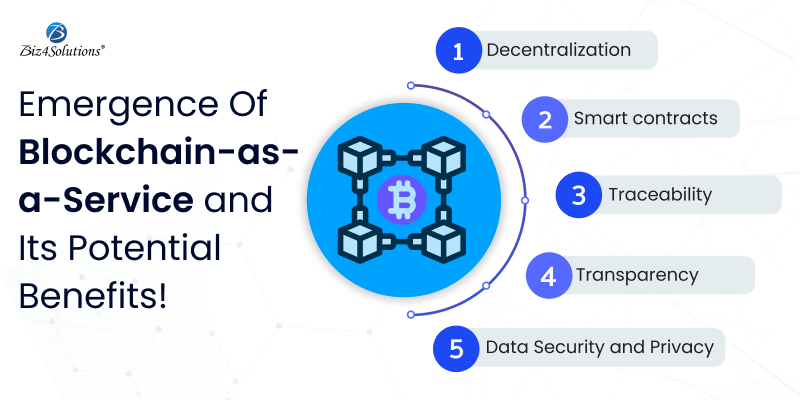
Decentralization
Here, decentralization means transferring control over data and related decisions from a centralized authority to a distributed network. Usually, most of the data is stored in local devices and computers and single entities monitor them. In case the employees are unavailable or those devices are shut down, accessing or restoring the data in real-time becomes tedious. In such cases, Blockchain is quite useful. It has a distributed ledger database where the data is stored in blocks. Here, data isn’t managed by any single node due to which other nodes too can access and control the data even if any single node isn’t working.
Smart Contracts
A smart contract is a contract where some particular conditions and situations are specified for the automatic execution of predefined tasks. These are programmed in such a manner that actions are taken automatically when the related terms of the agreements are performed. All this drastically reduces the requirement of intermediaries, enhances the speed of execution, makes the transactions cost-effective, and more reliable, and secure.
Smart contracts are employed in several applications like voting systems, supply chain management, healthcare data processing, payment and rent agreements, identity access, personal information access, intellectual property rights understanding, royalty distribution agreement, etc.
Traceability
All the data is stored and can be accessed publicly in a Blockchain system, allowing everyone to view it and make modifications to it for ensuring no false data is used. But, the whole process is governed by Blockchain consensus algorithms. Due to this, without the permission of all other participants, no one can make any alterations. Also, nodes are used for recording every single action taken. Thus, traceability is ensured resulting in effective communication and improved business relationships.
Transparency
Along with traceability, Blockchain app development also ensures transparency in the business processes. Since Blockchain is unchangeable in nature, the data in the blocks can’t be added, modified, or eliminated anonymously. Also, it is possible to track everything in real-time due to the distributed ledger technology. All this ensures accountability, gains the trust of the clients, and thus, improves business relationships.
Data Security and Privacy
As explained earlier, all the data and content are open, accessible publicly, and encrypted. However, only the users that are approved by the node manager can access the content and modify it. This property of Blockchain leads to high security and privacy of data from those outside the complete system.
Cases of data breaches and hacking crimes are on the rise and Blockchain’s security feature can tackle this problem completely. It applies several cryptographic techniques, hash keys, Merkle trees, etc. making it highly difficult to revise or steal the data. Besides, projects like Eximchain and Signal have been developed to ensure seamless and secure business communication and transactions.
Pros And Cons of BaaS
Take a look at the pros and cons of Blockchain as a Service
Pros:
- Ease of use due to the availability of ready-made customizable templates and modules.
- Outsourcing tasks like operations, implementation, and maintenance to the BaaS partner greatly helps in reducing operational costs to a large extent.
- Focused on customization
- High security and protection from fraudulent transactions
- Owing to the customizable modules and templates that BaaS provides, there is an ease of use in developing Blockchain systems.
Cons:
- Possibility of service disruption. Issues in business continuity in case the service provider goes bankrupt
- Low control and visibility of the owners due to dependency on BaaS service providers
- Challenges in data compliance
- Still in its infancy. Businesses do not have in-depth knowledge of how it works. Also, finding adept Blockchain app developers is quite difficult.
Wrap-Up:
The world is witnessing the emergence of various Blockchain-based services at a fast pace. Blockchain app development and BaaS solution for business are impacting numerous industries like Information Technology, Insurance, Healthcare, eCommerce, Entertainment industry, Advertising, Retail, Finance Industry, Cloud Computing, Energy, Government Projects, etc. with a wide range of applications.
These are promising offerings that can revolutionize business functions and help organizations gain a competitive advantage. Adoption of Blockchain app development services can provide businesses of all categories an opportunity to emerge as a leader and a pioneer amongst their peers. The organizations leveraging this technology are sure to bring a paradigm shift in the way they deal with data and perform several business transactions.
How are Mobile Apps shaping the Future of e-Learning?
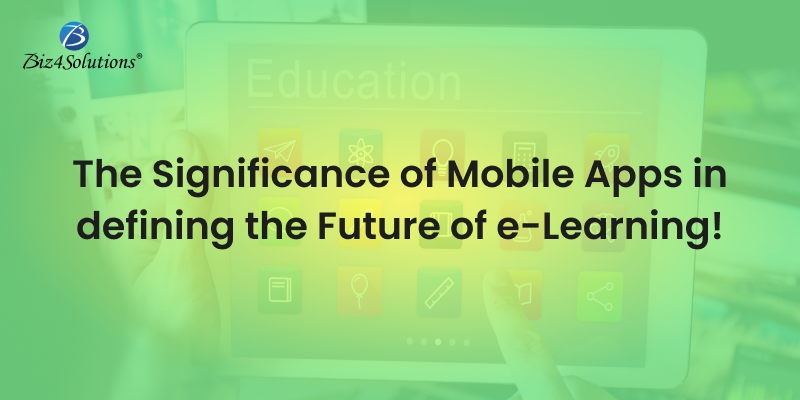
The education industry is undergoing a sea change with the rising popularity of eLearning apps. The eLearning sector is booming like never before. Peek through an interesting statistical fact stated by the popular research portal Research and Markets:
“The market value of the eLearning sector will touch US$ 350 billion by the year 2025 thanks to technological innovations.”
With multiple disruptive advantages over conventional learning, online learning is gaining momentum at a fast pace. A well-designed eLearning solution addresses several limitations existing in traditional learning and offers transformative add-ons like never before. Also, multiple disruptive technologies have revolutionized and broadened the spectrum of eLearning. Today, it has become one of the lucrative options for learners, instructors, and educational institutions unanimously. eLearning is constantly evolving and promises a brighter future for the education sector.
This post provides detailed insights about the basic and advanced features to include in a future-friendly eLearning mobile app and discusses the advantages of eLearning.
Basic Features to include in a new-age eLearning App
User-friendly UI/UX
A user-friendly interface design and a smooth user experience are must-haves for an eLearning app. An aesthetic design and easy navigation are driving factors to make an app all the more pleasing, appealing, and widely acceptable. So, avoid using complex features that are not necessary. This will cause confusion amongst users and lead them to abandon your app. Therefore, design an easy-going UI and integrate the relevant functionalities only.
Support for different Learning Formats
An eLearning application needs something more than just simple and monotonous printed lessons. Most eLearning apps support multiple course formats like podcasts, captivating pictures, audio lessons, high-definition videos, etc.
Video Lessons
Video content & live streaming are must-have features of an eLearning mobile app that makes it stand out from traditional teaching methodologies. Whether it’s a live video streaming session with the faculty or eLearning content in the form of pre-recorded videos, the impact on students is profound.
Also, video sessions are recorded so that students who have missed the session can attend the lectures at a convenient time. Recorded sessions can be replayed by learners as many times as they wish to gain a better understanding of the subject matter. Students have the convenience to pause and then replay videos resulting in improved comprehension. This approach resolves one of the most age-old challenges of conventional learning and elevates learning experiences to the next level.
Progress Report Generation
eLearning applications must provide users with instant performance feedback by generating progress reports. Such reports assess a learner’s performance from different angles like the level of understanding, the degree of exam preparedness, etc. Clear and concise reports help the students and their instructors to identify the area where the learner is struggling.
Offline Support
This feature is crucial to make an eLearning app more engaging and enhance its usability. Users may not always have access to an internet connection or may face connectivity issues at times. Learners can download educational content and access it in an offline mode. So, whenever the internet connectivity is disrupted because of a glitch or slow loading speed; the offline mode saves hassles for learners.
Multi-language Support
If your eLearning app targets global audience groups, it should support the relevant languages. An app will lose its value if users located in certain parts of the world are not able to access it due to language barriers. An eLearning app with multi-language support will be widely accepted globally and will maximize audience outreach.
Revolutionary Offerings of Modern-day eLearning Apps
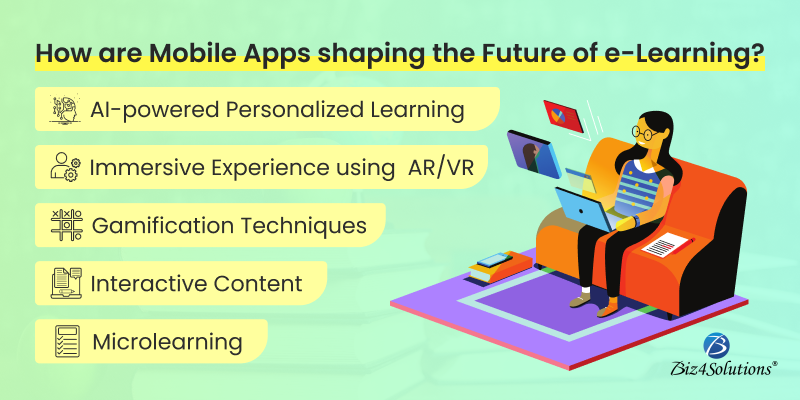
Microlearning
Microlearning is a popular eLearning approach offered by mobile applications. Modern-age learners have a shorter attention span and the microlearning approach aims to address this issue. Here, apps generate bite-sized learning content so that users can consume information in the form of small-sized manageable chunks. This makes room for repetitive study and helps users to retain information more easily.
Interactive Content
New-age eLearning mobile app development solutions provide interactive content like animations, videos, audio files, quizzes, and simulations. Live tutorials and doubt-clearing sessions are highly sought-after functionalities. Such an approach facilitates interaction and communication between learners and instructors.
Coming to quizzes, you can include different formats. Some examples are filing the blank spaces, MCQs, sorting & matching to essays & surveys, etc. You can also have leaderboards, define limits for tests, include random questions, and offer interesting hints wherever needed.
Interactive content makes learning more fun, exciting, and engaging. Hence, users’ learning outcomes are more productive and they can retain information better.
AI-powered Personalized Learning
Artificial intelligence adds to the productivity of an eLearning app by delivering personalized learning experiences. AI-powered algorithms identify the specific requirements of every learner, track a student’s progress, and figure out the areas of improvement required. AI/ML algorithms also generate customized study material tailored to meet the unique interests and preferences of learners. AI-empowered apps analyze the behavior of every learner to produce such targeted content. Moreover, if a learner finds it difficult to grasp a specific concept, the app provides extra study material based on their needs. This helps the learners learn at their own pace and allows them extra time and guidance until they master a concept entirely. As such, the usage of Artificial Intelligence & Machine Learning guarantees improved learning outcomes and adds value to the teaching-learning process.
Immersive Experience using AR/VR
Virtual Reality and Augmented Reality have made their way into the eLearning landscape. AR/VR-empowered eLearning mobile solutions offer learners an immersive experience. The potential of AR/VR lies in the fact that these technologies can create an illusionary circumstance to make learners virtually experience what they are learning. A virtual immersive experience creates an everlasting impact on human brains and proves way more effective than traditional teaching-learning methodologies. It helps a student to process information faster and retain the information. Hence, AR/VR wearables assist students to grasp a subject better. Imagine a scenario where students get a virtual feel of space, historical events, or visiting various places in the world.
AR/VR solutions also provide effective training scenarios. For example, employees undergoing safety training using VR headsets would get the real feel of emergencies without having to face danger.
Gamification Techniques
Some eLearning apps even offer gaming elements for learners. Now, the question that pops up in your mind is: “Are gamification elements of any use to a teaching-learning solution?” Well, gamification is a disruptive feature that motivates users to learn better and improve their performance. But, how? Elements like leaderboards, earning points and badges for achievements, etc. add a new meaning to learning. Learners try to excel for earning rewards and faring better than their co-learners.
eLearning Mobile Apps: Key Advantages
Flexibility & Accessibility
Traditional classrooms are mostly restricted to young learners. Conventional learning methods are not much useful for learners who are unable to attend offline classes. eLearning mobile applications have resolved this limitation and brought learning out of the confines of classroom teaching. Individuals can access courses regardless of their age or availability.
eLearning mobile applications make study material available to users in the form of videos or audio on users’ smartphones. So, learners can access educational content and other resources from any place and at any time. All they need is a mobile phone and an internet connection for accessing education. For example, learners get the advantage of accessing learning material while waiting in queues, in transit, or during work breaks.
Due to such a high level of flexibility, users with super-busy schedules can adjust their study time at their convenience quite easily. This way, busy learners can access knowledge without having to disrupt their daily routines.
Peer-to-peer Collaboration
Most eLearning solutions offer the functionality of learner-instructor interaction via messaging. But, not every solution offers collaboration with other learners. Peer-to-peer collaboration is a desirable feature in an eLearning solution that modern-day mobile apps offer. Features like discussion forums, chat rooms, group projects, etc. facilitate collaboration among learners. Learners can remotely connect and interact with other learners and instructors regardless of their location. This approach promotes knowledge sharing between peers. Also, learners experience the feeling of community learning.
Self-dependency
eLearning app solutions promote self-dependency among students as well as instructors. Students have to no longer depend on school teaching to gain educational insights, extra knowledge, or study material for competitive exams. With access to eLearning, factors like a student’s inability to attend classes due to illness or physical disability, a teacher’s absence from classes, non-availability of books, or long vacations cannot hamper the flow of education.
Teachers need not depend on conventional classes to earn a living. Instructors can take classes online from anywhere at any time regardless of any barriers like mobility issues, location, etc.
Cost-effectiveness
One of the major reasons why a learner and educational institute invest in an eLearning mobile app solution is cost efficiency. Learners need not travel to conventional classrooms or buy books. This saves time and money.
An educational institute finds it immensely profitable to impart education through an app rather than traditional classroom settings. Institutes save on infrastructure costs, overheads, etc. You need not spend on traditional teaching resources like pen, paper, books, etc. A well-designed admin dashboard saves administrative costs as well.
So, education industry providers investing in eLearning app development can save costs considerably. The only expense you need to incur is a one-time setup cost at the beginning. You need to hire professional programmers who will develop a custom eLearning app based on your specific requirements. Once developed, an eLearning solution will be a continuous source of revenue generation without having to bear maintenance expenses. Also, you can upscale or downscale your business operations effortlessly as per the demand.
Closing Views
eLearning apps have transformed the way people learn and gain access to educational material. And, eLearning mobile apps have revolutionized this approach further. Now, accessing education is a finger click away. Furthermore, cutting-edge technologies like AI, ML, AR, VR, etc. are opening up new avenues never thought of before. Benefits like flexibility, accessibility, personalization, improved interaction, user engagement, and cost-efficiency; are driving factors to elevate eLearning to unimaginable heights.
The demand for eLearning mobile solutions is higher than ever before. It’s the right time to invest in eLearning mobile app development. If you would like to design a transformative eLearning mobile app, partner with a professional mobile app development company with experience in building eLearning solutions.
12 Types of Trending Healthcare Software
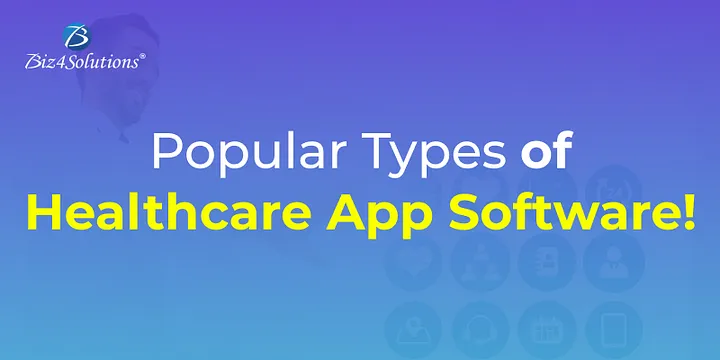
Advancement in technology has opened the door to digital transformation in healthcare. The stakeholders are adopting new technologies to develop scalable, accessible, affordable, and sustainable healthcare solutions. The healthcare industry generates a humungous amount of data from different components including patients, hospitals, trauma care, and labs. Health applications are being introduced to unify and streamline this complex data using technology and the internet. Many medical applications have been developed to connect individuals at different locations with different skill sets and functions. The aim is to solve the problems of medical care with standard software engineering solutions.
Many healthcare apps have been launched in different healthcare domains such as health diagnostics and healthcare informatics. These apps have different designs, functions, and implementations. Here is a list of 12 types of popular healthcare industry applications benefitting the healthcare sector in multiple ways.
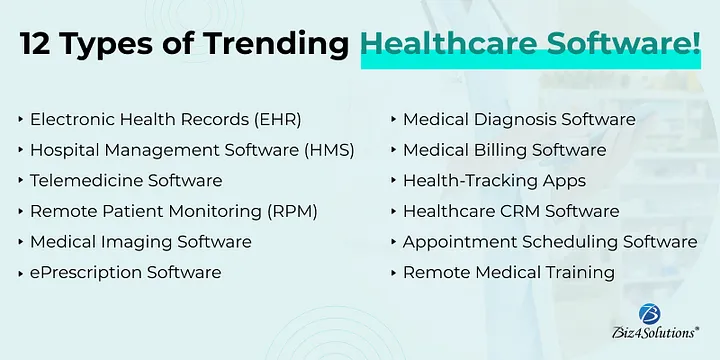
1. Electronic Health Records (EHR)
EHR is one of the emerging technologies in healthcare software applications wherein the healthcare provider and patients can benefit from the ability to electronically exchange and save health information. Healthcare organizations are adopting such technology to provide quality and safe medical care. The quick and up-to-date health-related information enables the healthcare provider to provide efficient and coordinated care. EHR apps bring in reliable, accurate, and streamlined care and billing. These technologies offer high security and privacy to patient data. Besides improved productivity, EHR offers higher efficiency to meet the business goals of any organization. The EHR can be further classified into two popular types – Electronic Patient Record (EPR) Software and Electronic Medical Record (EMR) Software. The former is used to store patient information and the latter is used to record different data such as medical types, medicine dosages, patient procedures, and recovery courses of patients.
2. Hospital Management Software (HMS)
HMS introduces management and information capabilities to help hospitals streamline their processes. HMS often has two separate portals for hospital management and patients. The former acts as a database for all information required for the administration and management of the hospital. The patient portal offers a digital page for registration, billing, insurance, and every other aspect concerning the patients. HMS solutions are known to offer numerous benefits including reduced paperwork, reduced cost, improved user experience, higher data security, streamlined communication, error-free administration, and location-free access to MIS reports. Such healthcare applications promote digital health which proves to be very beneficial in crisis-like situations such as the COVID-19 pandemic where we stressed to implementation of paperless and remote communication.
3. Telemedicine Software
The Telemedicine industry is booming at a fast pace. Statistics suggest that by the end of the year 2025, the industry will value at about $64 Billion. The COVID-19 pandemic has immensely contributed to this growth. Telemedicine is one of the profitable healthcare IT apps that enable patients to communicate with doctors and healthcare providers from remote locations. The patients can get appointments with the healthcare providers and communicate with them using chat messaging, emails, video calls, and telephone calls. It is one of the many profitable healthcare app solutions that facilitate people (elderly people, people with disabilities, and people living in isolated areas) with the potential to connect with healthcare providers from the comfort of their homes. Many healthcare companies are readily hiring healthcare app developers to develop productive solutions and capture consumers from the remote corners of the country.
4. Remote Patient Monitoring (RPM)
Healthcare providers have come up with healthcare solutions to monitor and collect patient data from remote locations. RPM solutions enable healthcare providers to collect health data, conduct diagnoses and alert the doctor in case of any abnormal behavior. Healthcare providers hire healthcare app Development Company to develop RPMs with unique features that satiates their requirements and business model. Different features of RPM include data analytics, reporting, online doctor-patient communication, and patient data security. These apps also come with text-to-speech functionalities to be used by people with disabilities. Taking a step further, healthcare providers are leveraging the potential of IoT to integrate RPM with different health-tracking wearable devices to keep a check on device failures.
5. Medical Imaging Software
Medical imaging software is gaining traction over its potential to analyze large datasets derived from images. Many radiologists use Machine Learning diagnostic tools with it to process a large volume of data and highlight the details that demand immediate attention from the doctor. These software solutions are also used to develop a customized 3D image of a human body or some specific body part. Such software facilitates the designing of equipment and body components such as coronary stents and prosthetic limbs.
6. ePrescription Software
These are one of the most commonly used healthcare apps. ePrescription software keeps a track of old prescriptions and assists healthcare providers in refilling and generating new prescriptions. This kind of software has become a must-have for doctors, enabling them to track patient history and save time. The ability to send the prescription to the pharmacy in just one click makes these apps very handy and time-efficient. They also notify drug allergies, keep a check on prescription drug errors, monitor the use of the controlled substance, promote paperless culture, and save time on medicine procurement.
7. Medical Diagnosis Software
Of all the medical software solutions and apps used in hospitals, healthcare diagnosis apps offer vast benefits to healthcare providers by offering a holistic view of the patient’s condition. Medical diagnosis healthcare software solutions have an automatic data-sharing feature that connects specialists from different departments and brings them to one platform. Healthcare professionals are integrating Artificial Intelligence in such healthcare software applications to process all the available patient information and provide a probable and potential diagnosis. At the same time, patients can use these apps to find out the severity of their medical condition and the need for medical consultation.
8. Medical Billing Software
Medical billing apps have emerged as one of the key healthcare software development solutions for financial operations. These apps help users manage receipts, invoices, and insurance. Many healthcare institutions integrate these apps with larger systems such as EHR. Many hospitals include this software in their healthcare services. The key features include automated accounting, financial management, claims management, and patient registration. In any integrated health system, such healthcare software gets uninterrupted access to a centralized patient database, that helps in medical coding and billing. Compliance strength is another important feature that boosts any medical billing service by automatically staying updated with the latest billing laws. Healthcare organizations are widening the horizons of their health services by integrating Business Intelligence into medical billing systems to gain business insights regarding revenue generation.
9. Health-Tracking Apps
Most of us must be aware of health-tracking apps that help us track our diet, overall well-being, and fitness. Wearable devices have only escalated the popularity of such medical apps. The mobile health apps industry has flourished over the last many years. The users get accurate health data such as Heart Rate and Oxygen level, enabling them to monitor their lifestyle and daily activities. Besides the trending usage, these apps have proved to be beneficial for patients in recovering from medical ailments. These apps can highlight changes in body parameters and alert the medical staff in case of any abnormal behavior. These health-tracking apps are promoting a healthy lifestyle to the common public.
10. Healthcare CRM Software
Healthcare Customer Relationship Management (CRM) software boosts the doctor-patient relationship by automating and streamlining different services. Medical institutions are using such healthcare app development solutions for patient acquisition and retention. Healthcare CRM software has multiple features including lead management, a patient portal, an appointment scheduler, analytics and reporting, and marketing automation. All these features can help any healthcare institution offer personalized services and achieve its business goals.
11. Appointment Scheduling Software
Health centers and physicians are increasingly adopting appointment scheduling software to streamline and speed up appointment scheduling. Appointment scheduling, sending reminders, rescheduling, and many other activities can be performed using this appointment-scheduling software. Such apps generate a clear picture of the doctor’s schedule. Also, such apps can automate the monotonous and manual work of receptionists and other workers. It comes with a patient-facing panel to be used by patients and a management panel to be used by the medical institution.
12. Remote Medical Training
It is one of the medical software applications that largely benefit the medical fraternity in training and education. Advanced technologies such as Augmented Reality are being integrated into such apps to boost the learning process. Surgery is one of the most beneficial areas. Such healthcare IT solutions are helping healthcare professionals to keep up with continuous medical education and the latest developments in healthcare. These apps are known to be cost-effective tools that cut down the cost of traveling and hiring resources for medical training. Remote medical training software is being used to train medical professionals at a large scale and at a fast pace.
Conclusion
Intelligent healthcare software solutions are simplifying and streamlining the healthcare system with advanced technologies like the Internet of Things (IoT) and Machine Learning (ML). These healthcare apps are positively influencing every aspect from appointment scheduling to patient recovery. Special attention has been given to improving communication between different stakeholders, healthcare providers, and patients. These healthcare IT solutions are reducing the workload of hospitals and other healthcare institutions. They have proven to be cost-effective, time-efficient, intelligent, resource-optimized, and sustainable, ready to cater to a large population.
Healthcare industry software applications have been trending and opening doors to new opportunities for revenue for healthcare institutions. Stepping into healthcare app development can prove to be a great move, given every component from market research to user testing is taken care of. For developing a profitable and HIPAA-compliant medical solution, it’s advisable to partner with a proficient software development company with domain-specific experience. An experienced firm can help you develop scalable and sustainable medical software that takes you closer to your business goals with every step.
Top PHP Development Tools to watch out for!
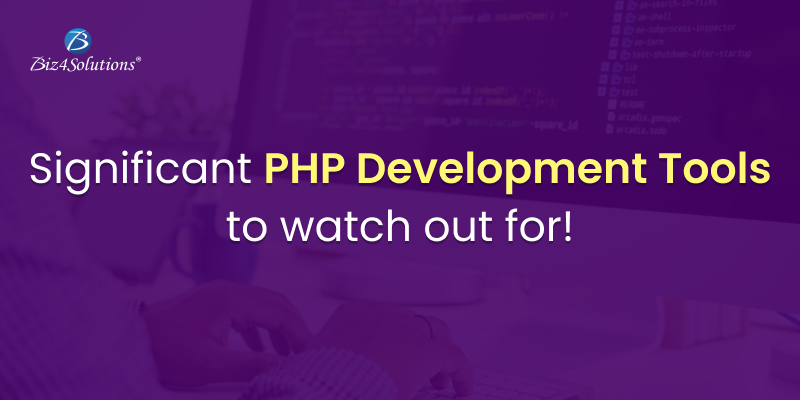
Hypertext Preprocessor, commonly known as PHP, happens to be one of the most widely used server-side scripting languages for developing web applications and websites. Renowned names like Facebook and WordPress are powered by PHP. The reasons for its popularity can be attributed to the following goodies PHP offers:
- Open-source and easy-to-use
- Comprehensive documentation
- Multiple ready-to-use scripts
- Strong community support
- Well-supported frameworks
However, to leverage this technology to the fullest and simplify tasks, PHP developers utilize certain tools that enhance programming efficiency and minimize development errors. PHP development tools provide a conducive IDE (Integrated Development Environment) that enhances the productivity of PHP web development.
The market currently is overflooded with PHP tools. Therefore, it becomes immensely difficult for PHP development teams to pick the perfect set of tools that will fulfill their project needs. This blog enlists the best PHP application development tools along with their offerings. A quick read will help you to choose the most befitting tool for your PHP development project.
Top PHP Software Development Tools
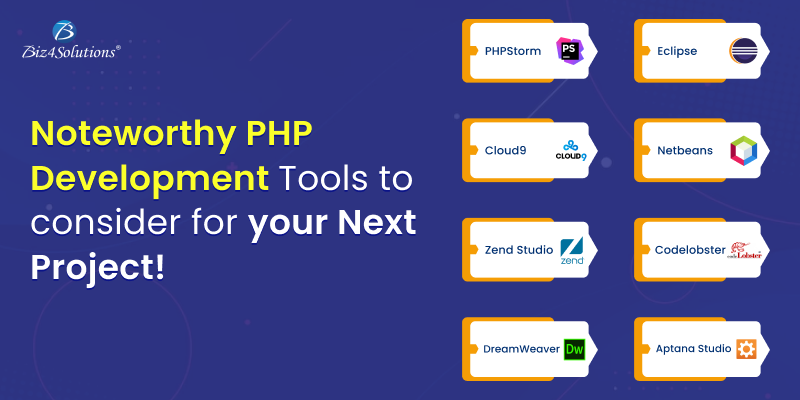
PHPStorm
PHPStorm, created and promoted by JetBrains, is one of the most standard IDEs for PHP developers. It is lightweight, smooth, and speedy. This tool works easily with popular PHP frameworks like Laravel, Symfony, Zend Framework, CakePHP, Yii, etc. as well as with contemporary Content Management Systems like WordPress, Drupal, and Magento. Besides PHP, this tool supports JavaScript, C, C#, Visual Basic, and C++ languages; and platforms such as Linux, Windows, and Mac OS X. This enterprise-grade IDE charges a license price for specialized developers, but is offered for free to students and teachers so that they can start open-source projects. Tech giants like Wikipedia, Yahoo, Cisco, Salesforce, and Expedia possess PHPStorm IDE licenses.
Features:
- Code-rearranging, code completion, zero-configuration, and debugging
- Support for Native ZenCoding and extension with numerous other handy plugins such as the VimEditor.
Functions:
- Provides live editing support for the leading front-end technologies like JavaScript, HTML5, CSS, TypeScript, Sass, CoffeeScript, Stylus, Less, etc.
- It supports code refactoring, debugging, and unit testing
- Enables a PHP developer to integrate with version control systems, databases, remote deployment, composer, vagrant, rest clients, command-line tools, etc.
- Coming to debugging, PHPStorm works with Xdebug and Zend Debugger locally as well as remotely.
Cloud 9
This PHP development tool is an open-source cloud IDE. It offers a development eco-system for PHP and numerous other programming languages like HTML5, JavaScript, C++, C, Python, etc. It supports platforms like Mac OS, Solaris, Linux, etc.
Features:
- Code reformatting, real-time language analysis, and tabbed file management.
- Availability of a wide range of themes
- In-built image editor for cropping, rotating, and resizing images
- An in-built terminal that allows one to view the command output from the server.
- Integrated debugger for setting a breakpoint
- Adjustable panels via drag and drop function
- Support for keyboard shortcuts resulting in easy access
Functions:
- With Cloud 9, one can write, run and debug the code using any browser. Developers can work from any location using a machine connected to the internet.
- It facilitates the creation of serverless apps, allowing the tasks of defining resources, executing serverless applications, and remote debugging.
- Its ability to pair programs and track all real-time inputs; enables one to share their development eco-system with peers.
Zend Studio
This commercial PHP IDE supports most of the latest PHP versions, specifically PHP 7, and platforms like Linux, Windows, and OS X. This tool boasts of an instinctive UI and provides most of the latest functionalities that are needed to quicken PHP web development. Zend Studio is being used by high-profile firms like BNP Paribas Credit Suisse, DHL, and Agilent Technologies.
Features:
- Support for PHP 7 express migration and effortless integration with the Zend server
- A sharp code editor supporting JavaScript, PHP, CSS, and HTML
- Speedier performance while indexing, validating, and searching for the PHP code
- Support for Git Flow, Docker, and the Eclipse plugin environment
- Integration with Z-Ray
- Debugging with Zend Debugger and Xdebug
- Deployment sustenance including cloud support for Microsoft Azure and Amazon AWS.
Functions:
- Enables developers to effortlessly organize the PHP app on more than one server.
- Provides developers the flexibility to write and debug the code without having to spare additional effort or time for these tasks.
- Provides support for mobile app development at the peak of live PHP applications and server system backend, for simplifying the task of harmonizing the current websites and web apps with mobile-based applications.
Eclipse
Eclipse is a cross-platform PHP editor and one of the top PHP development tools. It is a perfect pick for large-scale PHP projects. It supports multiple languages – C, C++, Ada, ABAP, COBOL, Haskell, Fortran, JavaScript, D, Julia, Java, NATURAL, Ruby, Python, Scheme, Groovy, Erlang, Clojure, Prolong, Lasso, Scala, etc. – and platforms like Linux, Windows, Solaris, and Mac OS.
Features:
- It provides one with a ready-made code template and automatically validates the syntax.
- It supports code refactoring – enhancing the code’s internal structure.
- It enables remote project management
Functions:
- Allows one to choose from a wide range of plugins, easing out the tasks of developing and simplifying complex PHP code.
- Helps in customizing and extending the IDE for fulfilling project requirements.
- Supports GUI as well as non-GUI applications.
Codelobster
Codelobster is an Integrated Development Environment that eases out and modernizes the PHP development processes. Its users do not need to worry about remembering the names of functions, attributes, tags, and arguments; as these are enabled through auto-complete functions. It supports languages like PHP, JavaScript, HTML, and CSS and platforms such as Windows, Linux, Ubuntu, Fedora, Mac OS, Linux, and Mint. Additionally, it offers exceptional plugins that enable it to function smoothly with myriad technologies like Drupal, Joomla, Twig, JQuery, CodeIgniter, Symfony, Node.js, VueJS, AngularJS, Laravel, Magento, BackboneJS, CakePHP, EmberJS, Phalcon, and Yii.
Offerings:
- It is an internal, free PHP debugger that enables validating the code locally.
- It auto-detects the existing server settings followed by configuring the related files and allowing one to utilize the debugger.
- It has the ability to highlight pairs of square brackets and helps in organizing files into the project.
- This PHP development tool displays a popup list comprising variables and constants.
- It allows one to hide code blocks that are presently not being used and to collapse the code for viewing it in detail.
Netbeans
Netbeans, packed with a rich set of features is quite popular in the realm of PHP development services. It supports several languages like English, Russian, Japanese, Portuguese, Brazilian, and simplified Chinese. Its recent version is lightweight and speedier, and specifically facilitates building PHP-based Web Applications with the most recent PHP versions. This PHP development tool is apt for large-scale web app development projects and works with the most trending PHP frameworks such as Symfony2, Zend, FuelPHP, CakePHP, Smarty, and WordPress CMS. It supports PHP, HTML5, C, C++, and JavaScript languages and Windows, Linux, MacOS, and Solaris platforms.
Features:
- Getter and setter generation, quick fixes, code templates, hints, and refactoring.
- Code folding and formatting; rectangular selection
- Smart code completion and try/catch code completion
- Syntax highlighter
DreamWeaver
This is one of the most popular PHP application software development tools. It assists one in creating, publishing, and managing websites. A website developed using DreamWeaver can be deployed to any web server.
Offerings:
- Ability to create dynamic websites that fits the screen sizes of different devices
- Availability of ready-to-use layouts for website development and a built-in HTML validator for code validation.
- Workspace customization capabilities
Aptana Studio
Aptana Studio is an open-source PHP development tool used to integrate with multiple client-side and server-side web technologies like PHP, CSS3, Python, RoR, HTML5, Ruby, etc. It is a high-performing and productive PHP IDE.
Features:
- Supports the most recent HTML5 specifications
- Collaborates with peers using actions like pull, push, and merge
- IDE customization and Git integration capabilities
- The ability to set breakpoints, inspect variables, and control the execution
Functions:
- Eases out PHP app development by supporting the debuggers and CLI
- Enables programmers to develop and test PHP apps within a single environment
- Leverages the flexibilities of Eclipse and also possesses detailed information on the range of support for each element of the popular browsers.
Final Verdict:
I hope this blog has given you clear visibility of the popular PHP tools used for web development and will guide you through selecting the right set of tools for your upcoming project. If you are a start-up or lack technical expertise in PHP application development, it’s advisable to hire an experienced PHP application development company for executing your project.
Biz4Solutions is a Texas-based software solutions company mainly focus on developing complex custom software solutions for our start-up and enterprise customers. We help our clients to achieve their goals on a global scale, offering our services to the clients from the U.S., Australia, Europe, and Asia Region. We collaborates with highly skilled and experienced solution architects and developers from india to help build top-quality products for our customers in technology services. We are proficient in IoT development, Mobile/Web application development,Robotic process automation(RPA), AI, , Cloud services and have done numerous large and complex projects for different industries. Interested to begin your digital transformation journey with Biz4Solutions? visit https://www.biz4solutions.com/
Pharmacy App Development: All you need to know!
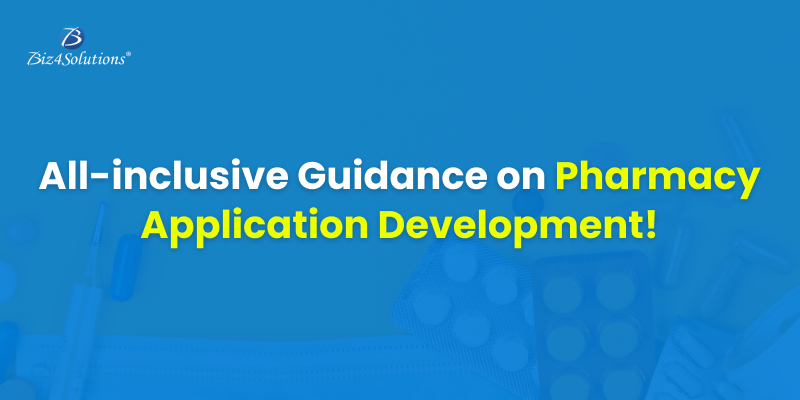
Online pharmacy apps have gained a lot of traction in recent years. Pharmacy providers as well as end-customers benefit from medicine delivery apps. Modern-era consumers prefer the convenience of online medicine ordering and doorstep delivery. Pharmacy services are utilizing apps as a tool for brand recognition and creating new channels for revenue generation.
Building an online pharmacy app is a great way to grow your business and establish your digital footprints amongst your target audience groups. So, this post explores pharmacy app development from different angles. A quick read will provide you with answers to the following questions:
What is a medicine delivery app?
What are the key Business Models of Pharmacy App Development?
What are the major Features to include in your application?
What are the advantages of Pharmacy Apps?
How to go about the online medicine delivery app development process?
So, let’s explore the different aspects of pharmacy app development!
What does an online Pharmacy App do?
A medicine delivery app allows consumers to order medicine online and get doorstep delivery. Buyers can choose from different options and reap the benefits of competitive pricing. Some pharmacy apps offer additional services like online booking of laboratory tests, preventive healthcare check-ups, etc.
Pharmacy App Business Models
You need to choose the right pharmacy app model that serves your business goals. The two most prominent online pharmacy app development models are the inventory-based model and the aggregator-based model.
Inventory-based Model
The inventory-based online pharmacy app model is applicable for licensed pharmacy businesses that have a huge inventory of medicines stored in offline stores or warehouses. Many of these businesses may operate through various regions as well.
This is how the inventory-based model functions. The ePharmacy receives online orders from consumers. Customers need to upload a valid scanned prescription or an ePrescription while placing the order. Then, a certified pharmacist verifies the prescriptions and the pharmacy dispenses medicines. Pharmacists pack the medicines inside a tamper-proof package and deliver them to consumers’ doorsteps using their in-house resources or a third-party delivery service.
Examples: Medlife, CareOnGo, Netmeds, and Myra.
Marketplace-based Model
The marketplace-based online pharmacy app model is an aggregator service; it connects the consumers to the pharmacy operators. It acts as a facilitator between licensed medicine suppliers and end-customers.
The owners of such pharmacy apps need not own medical supplies. They tie up with licensed medical providers or third-party pharmacies. The pharmacy providers registered with the app enlist their products on the website or mobile app. Consumers compare different pharmacies, choose products, and place orders. The marketplace app aggregates medicine orders from end customers, processes orders, and sends those orders to external pharmacy delivery drivers. Such an app is also called a Prescription delivery app. Pharmacies then verify the price and prepare the order. The pharmacy may also cancel the order if there isn’t any valid prescription against a specific order. The end customers get home delivery of their orders through a courier service.
Examples: PharmEasy and 1MG.
Pharmacy App: Key Features
Take a look at the basic and advanced features of a complete online pharmacy app development solution. A complete solution comes with different categories.
Customer App
Basic Features:
- A UI that’s easy to navigate
- User profile with the necessary details
- Registration/Login
- Prescription uploading
- Category-wise browsing with advanced search filters
- Medicine details with usage instructions & possible side effects
- Comparison of medicine pricing across various pharmacies
- Substitutes of unavailable medicines
- Saving order history and the option to repeat orders
- Order tracking
- Secured wallet system and multiple payment modes
Advanced Features:
- Automated prescription refilling reminders based on the previously uploaded prescription data
- In-app chat for real-time interaction with a certified pharmacist
- Chat options for addressing consumer concerns
- Multi-lingual capabilities
- Voice commands
- AI-powered personalized recommendations
- Consumer Loyalty Programs (points for each purchase that can be redeemed)
Admin’s Dashboard
Basic Features:
- User management & pharmacy management
- Order tracking & management
- Tracking received orders and incomplete/ongoing deliveries
- Managing Returns & Refunds
- Report generation in a few clicks
- Order verification
- Managing inventories & earnings
- Real-time notification on stocks – low inventory levels & drug expiry dates
- Performance tracking analytics & reports
- Customized Campaigns
Advanced Features:
- Consumer profiles integrated with EHR to get data on a patient’s past treatment history
- Aggregation with pathology & imaging labs displaying pricing information
- Number Masking to protect users’ identities (Only the admin & delivery agents have user information)
- CRMs for tapping prospects
Vendor’s Dashboard
Features:
- Vendor profiles with delivery histories
- Status of medicine availability along with timelines
- Push notifications related to order requests
- Management of order requests
- Real-time insights regarding medicine delivery drivers
- On-demand report generation on orders, sales, & daily transactions
Driver (Delivery Personnel) App
Features:
- Driver profile with the necessary details
- Tracking of location
- Information on delivery & order status
- Google Map integration to optimize routes
- Instant Notifications for completed deliveries & new order requests
Pharmacy App: Advantages
Consumer’s Perspective
Online pharmacy app users enjoy better accessibility to medicine delivery services and an elevated customer experience. An app allows consumers to order medicines and other related products from any store regardless of their location. Consumers can search for the desired medicines or medical equipment easily and quickly and that too from the comfort of their homes. Advanced search filters make the search activity more precise and save users time and effort. Users can get their prescriptions verified by licensed pharmacists. So, they can be assured that they are taking the correct medication and the right dosage, ruling out any chances of grave errors.
Users can compare the medicine prices and choose from multiple pharmacies. Some online pharmacy applications even allow consumers to schedule the order delivery at their convenient timings. For instance, one can set delivery hour preferences like post 5 PM or opt for weekend delivery. This benefits consumers with busy schedules. Real-time tracking enables customers stay informed about the delivery status of their orders. The customer support feature helps users resolve their queries and concerns in real time.
Reminders for taking medication and prescription refills before the stock of their current medication is over, are an added advantage for individuals using a pharmacy app. Moreover, online pharmacy apps adhere to security protocols. Hence, consumers’ data is safe and their purchases are kept private.
Also, patients get detailed information on a specific medicine and its side effects. Some pharmacy solutions offer add-ons like online healthcare consultations and booking of emergency services like ambulances. These services are real deal-breakers for several consumers.
Business’s Perspective
An online pharmacy app brings a lot to the table for pharmacy stores. Some examples are speedy medicine deliveries, 24X7 customer support, secure packaging, discounted offers on medicines, and crucial medicine-related reminders. As such, pharmacy stores leveraging apps can effortlessly gain customer loyalty. Also, you’ll be able to move your pharmacy business beyond the confines of your brick & mortar store and maximize customer outreach.
An app helps pharmacy owners to provide amazing customer experiences just as the consumers are looking for. This applies to not just medicine delivery but also other related services like medical tests, virtual doctor consultations, and many more. Modern-day pharmacy app developers are implementing more such disruptive features that add immense value to a pharmacy solution’s usability. The outcome is happy customers.
Pharmacy apps are quite effective in creating new avenues of revenue generation and boosting sales of pharmacy stores as well as pharmacy delivery aggregators.
Key Steps to develop an online Pharmacy App
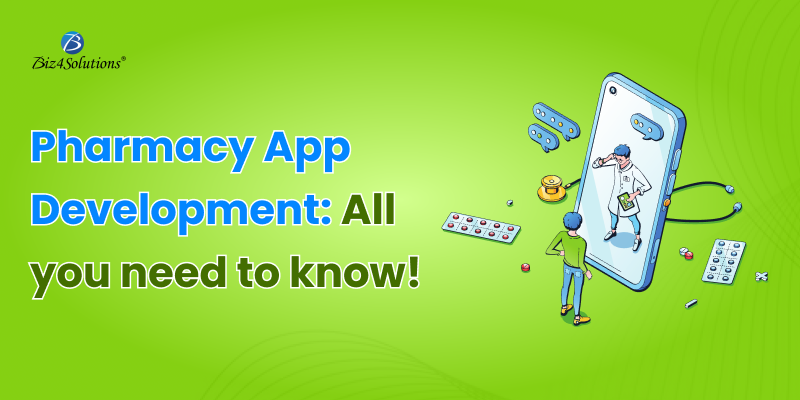
Define the Scope & Functionalities
Determine what purpose your pharmacy app will serve and which functionalities it will offer. Include a combination of generic and advanced features. Also, include USPs.
Pick the correct combination of Platform and Programming Languages
There are a wide variety of platforms and programming languages to choose from. You need to pick the right combination that fits into your existing skills and use case requirements. For example, choose the programming language Java for the Android platform and pick Swift if you are targeting iOS. If you plan to go for cross-platform development (android & iOS), React Native will be an apt choice.
Design the UI
Create the UI (User Interface) and UX (User Experience) design. While creating the design keep in mind that the UI should be clean and user-friendly. Make an intuitive design that is easy to use.
Develop the Backend of the App
The pharmacy app’s backend will communicate with servers and handle crucial tasks like data storage and processing. Develop the app’s backend to be reliable, scalable, and secure.
Integrate the necessary APIs
An online pharmacy app requires integration with certain external healthcare systems and devices for certain functions. So, integrate the necessary APIs so that your application can communicate with other services & systems like EHR (Electronic Health Records), drug databases, pharmacy management systems, etc. Integration with external healthcare systems will allow your app to offer additional features and data to end customers.
Test, Launch, & Maintain your App
Thoroughly test your pharmacy app to identify bugs and check whether the features are working as expected. For this, you can employ automated testing tools or hire a QA specialist for carrying out manual testing. I would recommend a combination of both- manual and automated testing - to achieve the best results.
Once you are satisfied with the app’s usability and sure that all the features are working as desired, it’s time to deploy your app. Launch your app in relevant stores like the Apple App Store and Google Play.
After your online pharmacy app goes live, maintain your app. Fix bugs and resolve issues at the earliest. Also, update your application with the latest features and security patches.
Closing Views
Developing an online pharmacy app can be challenging. It requires a combination of software development skills, interface design capabilities, and knowledge of pharmacy delivery operations. You also need to know about the ongoing trends and most wanted functionalities consumers look for in a pharmacy app.
But, if you plan the product development lifestyle carefully, follow the best practices, and comply with mandated regulations like HIPAA; you can create a valuable solution. So, select the right Software development service for executing your project.
Significant Healthcare Tech Trends to watch out for!

Healthcare is an ever-evolving sector that continues to expand its reach and influence with the help of avant-garde technologies. Increased awareness of health and disease, along with advances in technology that support it, make healthcare a booming industry. Advancements in the healthcare industry will continue to grow in leaps and bounds as medical technology continues to advance at a rapid rate. The emergence of cutting-edge technologies comes with game-changing healthcare solutions that open up new avenues of treatment and transforms healthcare diagnosis altogether.
Here are the most significant healthcare technology trends! Take a look at these amazing trends and learn what they bring to the table. Every healthcare provider should be aware of the ongoing healthcare technology trends to stay relevant in the ever-evolving healthcare sector.
Biggest Healthcare Technology Trends

Drones for Healthcare Delivery
Drones for delivery are one of the most recent and promising healthcare technology trends. Already, companies like Amazon are testing the waters with their drones. Drones are UAVs (Unmanned Ariel Vehicles) that people use for transporting healthcare-related items like medical supplies, vaccines, etc. to remote areas that are difficult to reach otherwise. Take a close look at some of the use cases.
Authorities can use drones to transport emergency medical supplies and other equipment to remote disaster-stricken locations. This way, healthcare providers and first responders can provide medical care & assistance quickly to the ones in need. And, the best part is that authorities can easily offer such aid regardless of the physical transportation barriers that the disaster has caused. Drones also make it easy to deliver vaccines to locations that are hard to reach using traditional means of transportation.
Besides, the use of drones makes it easier and quicker to transport stuff like medicines, blood, and diagnostic test samples. Such a service proves immensely beneficial when you need to ensure the timely delivery of critical medical supplies. If Drones are equipped with telemedicine technology, you can also use them to offer doctor consultations and medical exams to patients residing in underserved and remote areas.
Drones for healthcare delivery have the potential to improve access to healthcare, boost the efficiency of healthcare services, and reduce costs at the same time. However, drones may involve regulatory and logistic challenges. And, you need to address such challenges for obtaining the best results from Drone usage.
Precision Medicine
A new term will dominate the healthcare industry in future years. It’s called precision medicine. Here, medical professionals collect information about an individual’s body proteins and genes. They use this data for diagnosing, treating, or preventing certain diseases. In other words, medical professionals leverage information about a person’s unique genetic built to tailor personalized treatment methodologies.
Precision medicine works wonders in cancer treatment. Physicians can gather crucial data about a tumor inside the human body and create a treatment plan accordingly. Doctors can also track the progress of the treatment and medication and create a prognosis.
Precision medicine is one of the most transformative emerging healthcare technology trends and this approach is gaining momentum due to the advances made in the fields of genomics and personalized medicine.
AI in Healthcare Diagnostics
Computer algorithms will play a greater role in the diagnosis of medical conditions due to the increased use of AI in healthcare.
As the human mind is a complex creation of memories, places, and systems; technology can now understand how things work and how they relate. For example, an algorithm can determine if two people are connected while sitting next to each other in a room or how it relates to money when one finds it difficult to make decisions.
This is possible due to the mind’s ability to communicate with each other and with technology.
The healthcare industry is leveraging this capability of Artificial Intelligence to gain unimaginable treatment outcomes. For example, an AI algorithm could determine if someone has a chronic disease and whether or not they are suffering from symptoms that are related to that disease. AI-powered healthcare solutions and tools are helping medical professionals analyze huge chunks of patient data for identifying patterns and trends. AI combined with Machine Learning, a subset of AI, can analyze data to identify patterns and offer personalized recommendations for medication or treatment based on the distinct health history and objectives of an individual. This is helping healthcare providers improve the correctness of healthcare metrics and also optimize the effectiveness of personalized treatment plans.
AI is one of the game-changing healthcare mobile app trends that’s proving its potential in the medical sector by improving diagnostic outcomes, reducing clinical errors, and personalizing treatment plans.
3D Printing
3D Printing is one of the most innovative healthcare technology trends and can completely transform the way healthcare devices are manufactured and distributed. The healthcare sector is using this technology to build customized medical devices and treatment options tailored to individual patient requirements. Software development services are using cutting-edge technologies like AR (Augmented Reality) and VR (Virtual Reality) to achieve the best outcomes from 3D printing. Check out some of the use case examples!
Prosthetics
With 3D printing, you can create customized prosthetics tailored based on a patient’s unique anatomy and requirements. This makes way for improved comfort and better treatment outcomes.
Implants
You can utilize 3D printing for customizing implants as well. Such implants perfectly match a person’s particular anatomy and integrate better with that person’s body, leading to the best outcomes.
Medical Models
You can create physical models of the human anatomy to provide much-needed pre-surgery understanding & planning and results in better decision-making.
Surgical Guides & Tools
3D printing enables healthcare industry experts to create surgical tools and guides that are tailored to a particular human anatomy. This minimizes the risks of surgical errors and improves treatment outcomes considerably.
Organ Printing
Organ printing is one of the most revolutionary healthcare technology trends that is expected in the future years. Researchers are exploring this approach. They are using 3D printing for creating functional organs used during transplants. This concept is in its formative stages but holds immense potential to disrupt the future of the healthcare industry.

Digital health coaches
A growing healthcare technology trend, digital coaches will take the world by storm in 2023. And, it has nothing to do with eating healthier foods. Coaches will train their clients in how to use modern technology to improve their wellness and health. Many people are already using this type of coaching today, but through the use of social media, smartphones, and other devices.
A health coach can also provide resources that match their level, such as certification programs or advanced training courses. Clients can either purchase one or hire a coach to help them navigate the technology on their own. With the system of digital healthcare coaching, it becomes easy for individuals to set wellness goals for themselves and achieve those goals under the guidance of professionals.
Health coaches connect with their clients on a personal level and guide them through the process of finding a wellness coach, signing up for training sessions, and actively practicing what they are learning in those sessions. Experts will guide individuals seeking medical advice, support, and guidance at any time and from anywhere. Coaches collect an individual’s health data using technologies like wearable apps and other smart devices or healthcare software solutions. Experts then analyze this data and track their client’s progress. Based on these results, coaches provide personalized advice on wellness parameters.
In Conclusion
Emerging technologies have already proved their potential in transforming the Healthcare Industry. More advanced technologies are expected to create a buzz in the coming years. New technologies promise to brighten the future of medical diagnoses and treatment. Hence, healthcare providers must necessarily explore these technology trends to stay ahead of the competition.
However, implementing new technological trends in your healthcare service offerings require professional expertise and sound technical knowledge. So, several providers are partnering with an experienced healthcare app development company, to smarten their service offerings using innovative technologies.
Web Development Checklists that provide Useful Guidance to Teams!
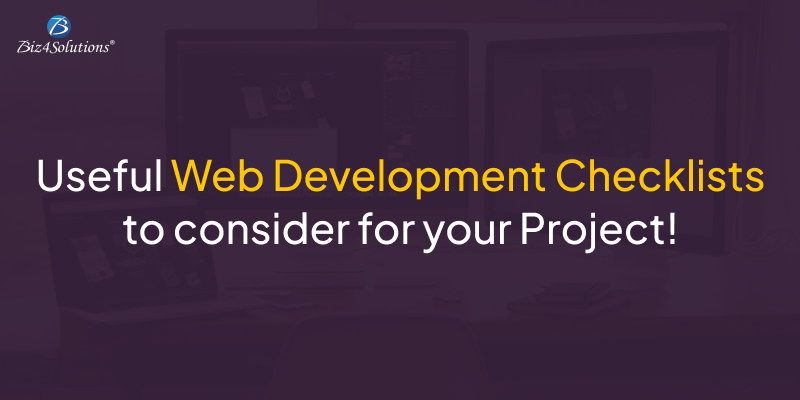
With the large number of Web Development technologies surfacing to build modern-day web apps, web app development is getting increasingly complex and challenging. With the internet brimming with abundant web applications, users abandon and switch to other web applications in no time, if the application fails to satisfy their expectations, thereby damaging the company’s brand reputation. So, for delivering a successful end product, the organization needs to carefully execute each of these developmental and promotional stages to minimize errors, conform to business objectives, and provide a rich user experience.
However, fulfilling all the aforesaid factors becomes quite complicated and time-consuming. Hence, chances of lapses are likely; specifically, if your team is inexperienced or in a hurry to complete a project within the set timeline. Therefore, the web development team should maintain a checklist of the essential tasks; to avoid any misses.
This blog provides web development checklists that your team needs to refer to; for building a successful web application or a website. The following checklists have been created by consolidating the inputs from software-sector veterans and will help a Web Application Development Company to ensure that important action items are not neglected or overlooked.
Before we dive deeper let’s have a look at why web development checklists are required.
Checks For Web Development
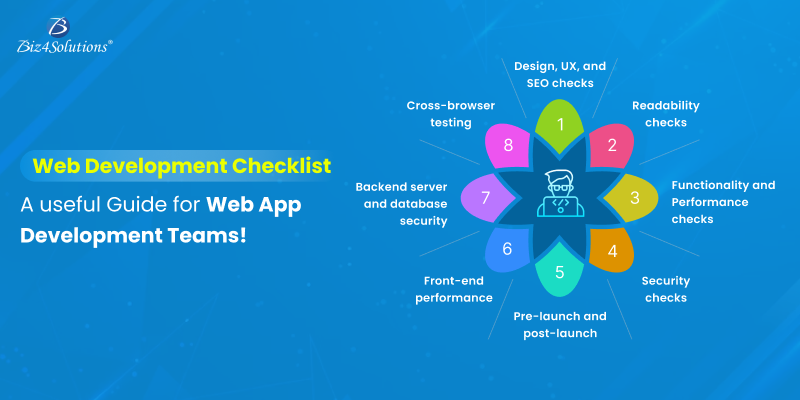
Every web development project must undergo the following validations to ensure the creation of a flawless website. Let’s have a look at the key checklists and understand their importance.
Design, UX, and SEO checks
Optimize your website for all kinds of devices – mobiles, tablets, laptops, and desktops.
- Get rid of irrelevant images.
- Check whether the UX design has been executed as per the set standards.
- Make sure your website is free of broken links and validation errors. Broken links – the links which show an error or the “page not found” message on clicking – adversely affect the UX and also the website’s SEO score.
- Remember to include meta tags – title, description, etc. – as they improve the website’s position and boost the chances of ranking in the search engines.
Readability checks
- Cross-check the website content for any possible mistakes regarding spelling, grammar, etc. before the website’s live launch.
- Make sure that your content is unique and free of plagiarism.
- Adjust the font style to ensure that your web page is easy to read and scan; as this factor is a game-changer in terms of user retention.
Functionality and Performance checks
- Check the appearance and loading speed of your images. In case they are slower in loading or appear blurred; have this problem fixed by optimizing the image size. Optimization of images improves performance as well as search engine rankings.
- Check the loading time of your website. If the loading time turns out to be more than 4 sec, get the issue fixed, or else it will adversely affect your viewership.
- Check your website’s rendering and performance on trending browsers such as Mozilla, Chrome, Safari, Opera, Internet Explorer, etc.
- Your website’s caching should always be turned on as caching optimizes the speed of a webpage and also minimizes the server load by minimizing scripts like JavaScript and CSS that are time-consuming. A cache plugin named ‘W3 Total Cache’ can be easily installed if WordPress is being used to build the website.
- Ensure that your web page involves effortless navigation and all the links are functional.
Security checks
- SSL (Secured Socket Layer): Possessing an SSL (Secured Socket Layer) certificate is desirable if your website gathers sensitive user information such as personal details, and credit card/banking particulars.
- An anti-malware Plugin: The usage of anti-malware plugins helps to combat malware threats and protect a website from viruses and malware attacks.
Handy Web Development Checklists and Their Offerings
Now have a look at the ready-made Web development checklists recommended for your team!
Checklists related to an app’s pre-launch and post-launch
The pre-launch checklist parameters include optimizing SEO, testing for bugs, optimizing performance, reviewing content, integrating social media, integrating analytics, devising a data backup & recovery plan, deployment plan, etc. The post-launch parameters include continuous monitoring, collecting user feedback, rolling out security and content updates, reviewing analytics, app promotion, offering user support, etc.
- The Essential Pre-launch Checklist for Your Website comprises functionality, design elements, cross-browser testing, content editing, and SEO.
- Website Launch Checklist by Glasgow developer offers tools for checking actions after completion, greying out items that are not applicable, and resetting the checklist to make it ready for the next project. It includes content editing, links’ testing, navigation usability, CSS and HTML validity, GDPR compliance, Communication, infrastructure, styles and scripts’ minification, compatibility, analytics, accessibility, performance, etc.
- The Essential Launch Checklist for Web Apps and Mobile Apps by Ben Cheng enables product managers to test the performance level, checking the legal compliances, security, compatibility, and broken links in applications.
Web Development Checklists on Front-end performance
These checklists guide you through carrying out front-end web app development tasks like making the design responsive, validating HTML and CSS, ensuring accessibility, optimizing performance, and cross-browser compatibility.
- A front-end Deployment Checklist by Fred Rocha, guides on validating the markup; and checking the performance, the console for JavaScript, and many more.
- The Front-end Checklist by David Dias is a digital interactive tool wherein one has to enter the project’s URL to get a full report on areas such as CSS, HTML, JavaScript, head, web fonts, images, SEO, performance, and accessibility. This check is an exhaustive one and categorizes items based on high, medium, or low-priority requirements.
- Front-end Performance Checklist 2020 by Vitaly Friedman offers the following items How to get ready on planning and metrics and how to set realistic goals, define the environment and assets, build and deliver optimizations, monitoring, testing, etc.
Web Development Checklists related to the backend server and database security
The following checklists provide guidance on executing the web app development tasks related to the server side. Some examples are configuring the server, designing the database, creating the APIs, etc.
- Back-end Best Practices provide stack-agonistic guidance on the best available practices involving different back-end architectures like security, data storage solutions, app monitoring, server environments, etc. It also offers a responsibility checklist for organizing the team tasks and a release checklist needed at the time of the launch of the app or website.
- Database Testing Checklist offers items regarding stored procedures, database integrity, field validation, transactions, security, constraints, etc.
Web Development Checklists on Cross-browser testing
Cross-browser testing is essential to make sure that a web app or a website looks and works consistently across various types of OSs and browsers. The key testing parameters include website layout, image rendering, responsiveness, font rendering, website functionality, audio & video playback, compatibility with existing browsers, etc.
- Cross-browser Testing Checklist Before Going Live includes testing on font rendering, element alignment, API connections, etc.
- Cross-browser Testing Checklist offers all items needed for testing on various browsers and OS.
Final Verdict:
Web application development involves multiple phases like web designing, development, project management, extensive testing, deployment & maintenance post-deployment. Each stage needs to be executed skillfully to avoid mistakes and costly rework. Additionally, the project has to be delivered within the set timeline. Therefore, chances of lapses are likely; particularly if your team lacks experience or is in a hurry to meet deadlines.
Thus, comprehensive knowledge about these web development checklists is essential for architecting a flawless and universally acceptable web app or website for your business.
Testing Animated Views in iOS Apps: Expert Guidance!
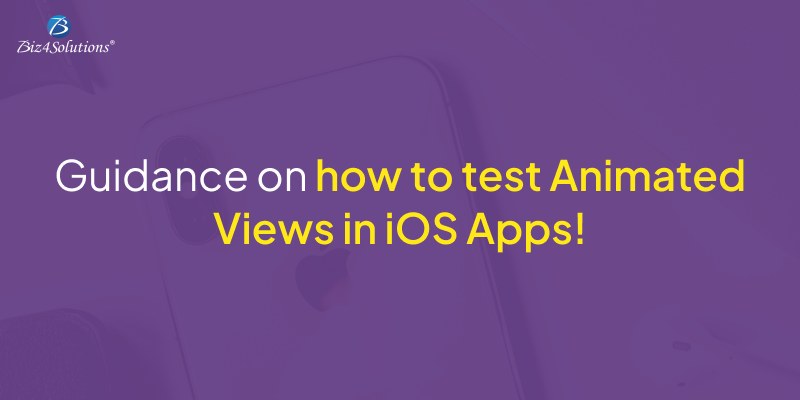
An animated view is a custom view that changes its look or appearance in response to some context. For example, a carousel layout has several slides that change in size and appearance in response to the user’s interaction. However, animated views will function as expected and provide an amazing UX only if they are tested correctly. And, it’s challenging to test animated views in iOS apps as animations involve time-based modifications in the UI.
This post enlists the right strategies and guides you through the correct process of testing animated views in iOS applications.
Key Steps to test animated views in iOS
- Identify the type of animation you intend to use in the app -zoom in/zoom out, fade in/fade out, slide in/slide out, etc.
- Set the duration time of the animation – the time taken for the completion of the animation. Decide on this time very carefully as it determines the effect of your animation.
- Identify the specific user interactions or the particular events that will trigger the animation to function. Examples of such triggers include scrolling, button tapping, etc.
- Examine how accurately and precisely the animation will be working or behaving.
- Check how the animation is impacting the app’s CPU, performance, and memory usage.
- Consider the feedback app users will get during and after the animation – visual indicators or haptic feedback.
Create a separate test target and also separate files for every component. This way, you can verify every component’s expected behavior separately. For creating a separate target for your test environment, go to ‘File’, then ‘New,’ and then ‘Target.’ Select the “iOS Unit Testing Bundle” present under the “Test” section. A new target gets created. You can use this target for writing tests for animated views. Also, create a test class for the animated views. This class should contain test cases that will simulate various stages of the animation process and assert that the views are going to function as desired.
The aforementioned steps will help you to set up a test environment for animations during iOS application development. This will enable you to conduct the testing process in a controlled and repeatable manner.
Now, identify the components present in the animation. Write test cases for every component to verify whether the components are working as desired. It’s recommended to use the Apple-provided XCTest framework for writing the tests. For instance, XCTestExpectation allows you to wait for the animation to get completed before you make any assertions. With this tool, you can test the behavior of the view at various phases of the animation.
Animations are likely to have dependencies like other views or data sources on other portions of the application. So, you need to isolate your tests and improve their reliability. For this, you need to use mock objects for the dependencies. This way, you will be able to test the app’s animation logic without having to worry about the other parts of the iOS application.
What are the different Methodologies to test Animated Views in iOS?
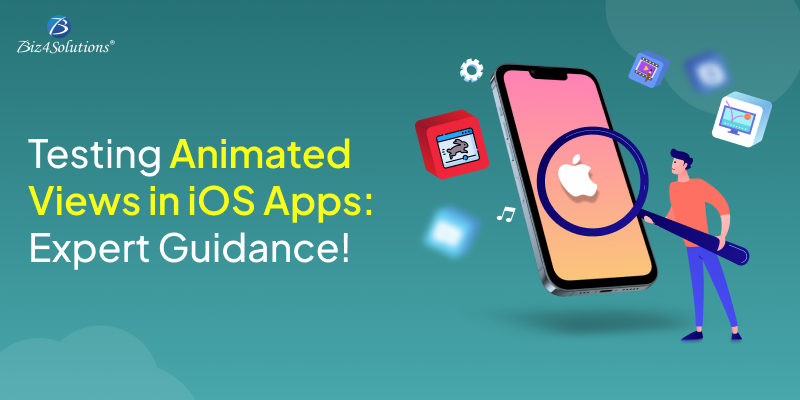
let animationExpectation = XCTestExpectation(description: "Animation completed")
// Start animation code here
// After the animation is completed, fulfill the expectation
animationCompletionHandler = {
animationExpectation.fulfill()
}
// Wait till the expectation gets fulfilled
wait(for: [animationExpectation], timeout: 5)
// Start animation code here
// At the end of the animation, perform the test
animationCompletionHandler = {
// Perform test here
}
// Start animation code here
// At the end of the animation, perform the test on the main queue
animationCompletionHandler = {
DispatchQueue.main.async {
// Perform test here
}
}
func testButtonAnimation() {
let app = XCUIApplication()
app.launch()
let button = app.buttons["myButton"]
button.tap()
// Verify the animation
let animationExpectation = expectation(description: "Button animation completed")
DispatchQueue.main.asyncAfter(deadline: .now() + 1.0) {
XCTAssertTrue(button.frame.origin.x > 0, "Button should move to the right during animation")
animationExpectation.fulfill()
}
waitForExpectations(timeout: 2.0, handler: nil)
}
Concluding Views:
Internet of Things (IoT) applications are transforming several industries in the ways never thought. Check out how smart IoT Applications can transform your Business Operations and fetch you a high ROI!
There are several IoT application development services in the market which deliver high-end IoT solutions to diverse industries. If you want to take your business to the next level of success with advanced IoT solutions, Biz4Solutions can be your partner. To know more about our IoT solutions, visit us at https://www.biz4solutions.com/internet-of-things/
How can Offshore Software Development Services contribute to bridging the Gaps in Your Business Operations?

The software outsourcing industry is growing in leaps and bounds! The advantages of offshore software development are being leveraged by large-scale as well as small-scale enterprises and even start-ups! Check out some interesting 2022 statistics researched by Zippia.com, about the US outsourcing industry!
- The value of the global software outsourcing market was $92.5 Billion in 2022. This accounted for $62 billion of the entire international market revenue.
- The US outsources approximately thirty-thousand jobs every year.
- 59% of companies outsource to cut costs.
- 66% of the business enterprises in the US outsource services for at least one department.
- 78% of the global organizations that outsource services hold a positive attitude towards their respective technology partners.
- The outsourcing market has been predicted to grow at a CAGR of 4% between the years 2021 and 2025.
Why is software outsourcing so popular? Well, this post discusses how offshore outsourcing models bridge the gap in existing IT operations and why every company, big or small, must consider offshore outsourcing.
Offshore Outsourcing Software Development Model

Offshore Software Development Services: Long-Term Advantages
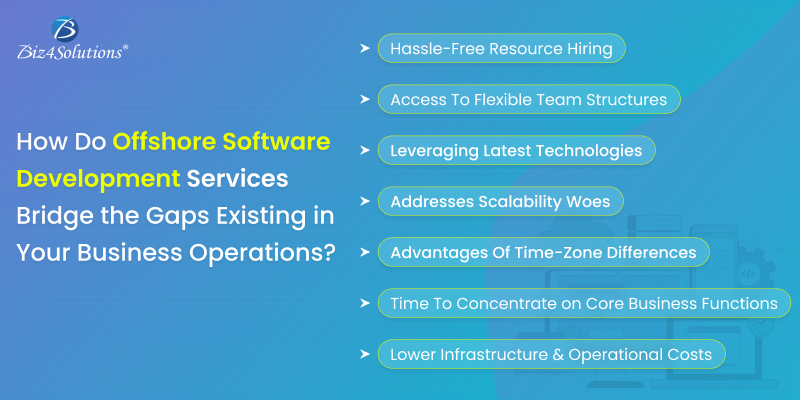
Hassle-Free Resource Hiring
For creating an in-house IT team from scratch, you need to invest an enormous amount of time, effort, and money. This is because, for carrying out the processes of recruitment, onboarding, and advanced training to the newly appointed resources; you need to assign resources, working hours as well as funding.
Contrarily, if you adopt the software outsourcing approach, you can save on the cost and hassles of recruitment processes. You just need to define the project requirement and your outsourcing partner will take care of the rest. The offshore firm will provide you with resources that best suit your project specs. The resources can be either dedicated developers or an entire team of software professionals depending on your need.
Usually, software development outsourcing services maintain a curated pool of pre-screened candidates and so, do not need to invest additional time in conducting screening tests, interviews, and coding assessments. As such, your partner company can build a perfect team for you much faster than you can imagine.
Access To Flexible Team Structures
Your business enterprise may not need resources with the same kind of skillsets all the time. A majority of IT projects require a team of professionals with expertise in different areas of IT during various product developmental stages. Moreover, the project requirement may change at any time to keep up with changing times. And, the more flexibility to change the technology stack, team structure, and business model; the faster will the project be able to adapt to ever-evolving specifications.
But, it’s difficult to achieve this flexibility with an in-house team, as it lacks a variety of skillsets. Mostly, you are left with very few options and have to settle down for the available resources even if they do not possess the required years of experience or specialized skills. Several companies invest in training their in-house resources for specific software development tasks.
In this regard, the offshore software development strategy proves beneficial as it offers a flexible team with a wide variety of skillsets for software engineers, programmers, developers, testers, etc. During the initial stages of the product development cycle, when more front-end engineers are needed, your software outsourcing vendor provides you with front-end development experts. And, when the server-side logic is being created, back-end development professionals will be allocated. This approach will be followed with each product development stage. As such, you’ll easily get specialized resources based on the requirement for each developmental phase.
Usage Of the Latest Technologies
Most of the distinguished outsourcing partners have specialists and certified professionals skilled in the latest cutting-edge technologies. Such kind of expertise is rare to find within in-house teams. However, knowledge and expertise to work with emerging tech stacks are necessary for crafting a product that is competitive and relevant as per the modern market requirements.
Addresses Scalability Woes
It’s difficult to identify beforehand how many resources you will be requiring at each stage of your software product development cycle. So, with an in-house development team, scaling up and down as per the project needs become challenging. You either end up overpaying for resources or fall short of resources at certain product development phases.
The offshore software development model helps you to successfully address scaling issues. You can hire extra resources and expand your team when the demand surges or you need to speed up the development process. And, when the demand for resources is low, you may reduce the number of specialists. Offshore partners usually offer various outsourcing models like resource augmentation or dedicated teams, and you get to pick the model that suits you best.
Advantages Of Time-Zone Differences
Remote resources of an offshore development company working from a different time zone may seem challenging to many but is actually a boon for product development. It leads to faster time-to-market. Remote offshore development teams working from different time zones with some overlapping hours make way for continuous services and round-the-clock development activity. And, as there’s always some resource working on the project, you can identify issues at the earliest and resolve them promptly.
This benefit is not available with in-house teams. So, during major service updates, your in-house resources need to work additional hours in late-night shifts. This again involves extra expenses in the form of additional wages to the staff. Contrarily, with the offshore software development approach, you always have IT professionals from different locations working on your project, a few hours ahead or behind your time zone. Hence, changes can be executed without disrupting the normal workflow or asking professionals to work extra hours.
Time To Concentrate on Core Business Functions
Business enterprises that have outsourced development tasks to offshore technology partners do not have to worry about managing complex, time-consuming, and hassle-prone tasks related to project development. This leaves them enough time and energy to focus on core business activities and decision-making processes.
Lower Infrastructure & Operational Costs
The in-house software development approach requires you to invest heavily in infrastructural & operational expenses like maintaining office spaces, employee recruitment, obtaining software licenses, paying salaries to IT professionals, employee supervision, and many more. Also, you need to spend a humongous amount to keep your IT ecosystem relevant and updated with the latest market trends.
Hence, outsourcing software development to third-party companies saves you from all hassles as you only need to pay for the services delivered by a dedicated development team or developers for the project assignment within a said timeline. However, the labor costs in some countries like the US, Australia, Canada, etc. are very high regardless of the experience and expertise of the workforce. On the other hand, outsourcing software development services in India will enable you to get a skilled workforce at minimal costs. Such an offshore business model promises to offer a partnership with experienced tech nerds, affordable product development rates, and flexible pricing models to choose from.
It has been observed so far that offshore software development services outsourced from South Asian countries like India offer the maximum value for your money.
Advanced Tools Used by Offshore Companies to Bridge the Communication Gap with Clients
It is essential for your in-house team to have continual and seamless communication with offshore software development teams. For this reason, most experienced outsourcing partners have a well-built communication infrastructure. It allows continuous, prompt, transparent, and secure communication with clients regardless of time-zone differences. Advanced tools such as Zoom, Slack, Skype, Hangout, Asana, LastPass, HelloSign, Hackpad, etc. are used for convenient and safe communication between both parties. For instance, Slack, Google Hangout, and Skype are utilized for offering regular updates, Jira for project updates, Hubstaff for managing time, GitHub for managing the code, and so on.
An experienced offshore software development company has been using these advanced communication tools for years and so, the team members are well-trained in their usage. Such tools allow the client to effortlessly track the performance of their offshore team members, handle reporting functions, and understand the status of the project at any given time. Team calls via video conferencing are one of the most popular practices for synching the members of teams working from different locations.
Wrapping Up:
The offshore software development model brings a lot to the table for business enterprises. It offers benefits like access to a large pool of talent, innovation, and expertise. Offshoring also promises a cost-efficient development cycle. Besides, you can get much-needed advice and new business insights from your experienced software outsourcing company, leading to productive outcomes and flawless decision-making.
You need to just select the right offshore team with the necessary experience and expertise needed for your project.
Deep Linking in React Native Apps: All you need to Know!
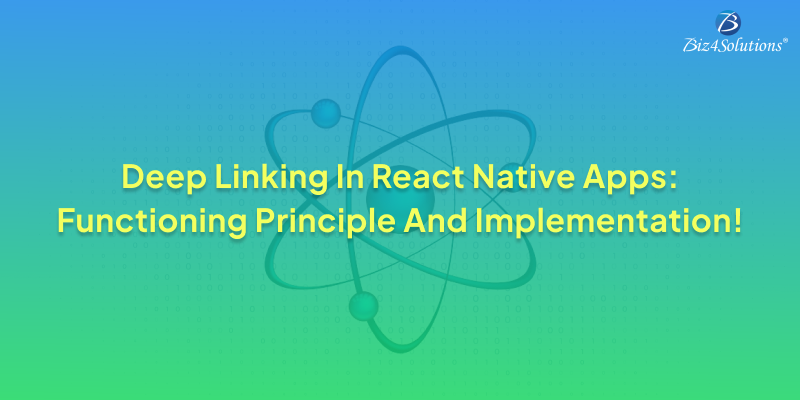
What Is Deep Linking?
How Does The Concept Of Deep Linking Work?
Deferred Deep Links?
What Are The Benefits Of Deep Linking?
How Can You Implement Deep Linking In React Native Apps?
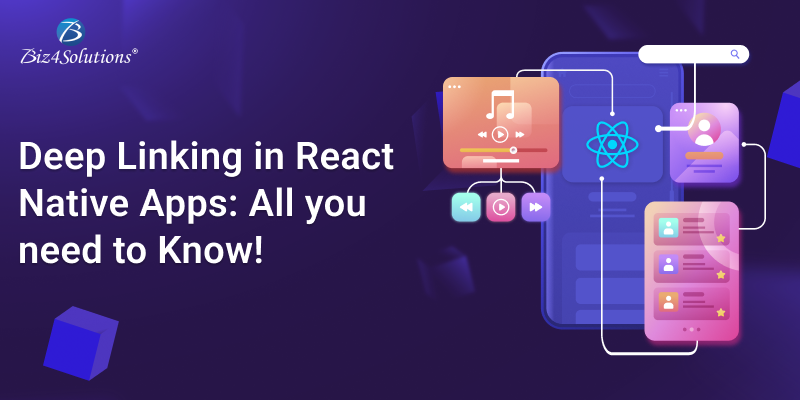
Configuring Deep Linking In IOS And Android
Configuring Deep Links In React Native Android Apps
Step#1 Defining Deep Links
<activity
android:name=”.ProductActivity”
android:label=”Product”>
<intent-filter>
<action android:name=”android.intent.action.VIEW” />
<category android:name=”android.intent.category.DEFAULT” />
<category android:name=”android.intent.category.BROWSABLE” />
<data
android:host=”example.com”
android:pathPrefix=”/products”
android:scheme=”http” />
<data
android:host=”example.com”
android:pathPrefix=”/products”
android:scheme=”https” />
</intent-filter>
</activity>

